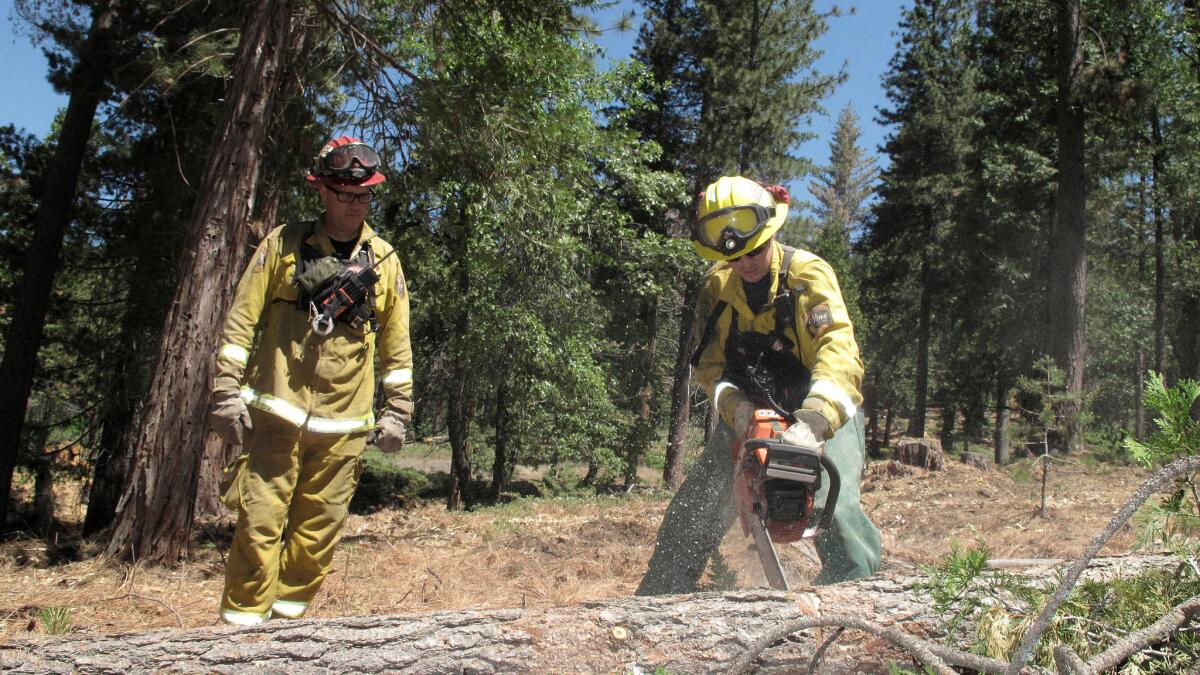Opinion: A burning debate over dead trees

- Share via
To the editor: All too often, media coverage of the recent tree mortality has focused only on negative portrayals without considering the ecological importance of dead trees to our forest ecosystems.
( “The forest for the trees,” Opinion, Sept. 25)
This op-ed was a helpful antidote to these common mis-perceptions, and provided readers with a better basis for making informed decisions about how Californians can safely coexist with the fires and beetle outbreaks that are a natural and inevitable part of our remarkable forest ecosystems.
Douglas Bevington, Kensington, Calif.
::
To the editor: I strongly disagree with the argument that we shouldn’t take action to address the millions of dead trees in our state and federal forests.
This is an issue of public safety and I approach it from the perspective of Californians whose lives are threatened by ever-more destructive wildfires. Dead trees are falling on roads and power lines and driving the increasingly damaging and unpredictable fires in recent years.
Efforts to remove dead trees should focus on the 5.5 million trees identified by Cal-Fire and the Forest Service that pose the highest risk to lives and property. While there is a significant cost to these projects, failure to reduce this fire risk will only lead to higher financial and human costs in the future.
Dianne Feinstein, Washington DC
The writer is a U.S. Senator for California
::
To the editor: Having cattle ranched in the west slope of the Central Sierra for the last 60 years, I wonder if Char Miller did the research for the opinion piece from an office. From what I see, in the alpine transition zone to the 5,000-foot level, the die-off of pines is massive.
There are swaths of acres without living mature conifers. The combination of the drought, fire suppression, and the beetle have negatively transformed hundreds of thousands of acres of the west slope for generations to come.
As to snags not burning any hotter than live trees, that is possible. However, fires in a forest of snags and dead needles spreads exponentially and skips and starts miles away as embers land in dead material far from the original combustion site.
Robert Rex, Calabasas
::
To the editor: As an advocate for for-
est conservation, I believe this op-ed by Char Miller does an excellent job distilling two important issues regarding dead trees in the Sierra: ensuring human safety but also protecting the important ecological role that dead trees play.
Unfortunately, politicians and the Forest Service are attempting to exploit fears about wildfire. I think they should instead be promoting something very different — protecting dead trees on the vast majority of our public lands to help wildlife — and focusing resources on areas adjacent to homes, campgrounds, and other structures where dead trees can pose safety hazards to humans.
Justin Augustine, Oakland
::
To the editor: I’m a retired national and state park ranger, and Miller’s well-informed perspective highlighted something that I think cannot be overstated : that dead trees, or snags, are extremely important for wildlife.
A century of devastating snag removal on public and private lands has left many wildlife populations in free fall. Let’s not play into the hands of the timber and bio-fuel industries. Let our many snag-dependent wildlife species have a chance to rebound and do their critical job of maintaining normal insect numbers in our forests. It just might help delay the next beetle outbreak.
Christy Sherr, Nevada City, Calif.
Follow the Opinion section on Twitter @latimesopinion and Facebook
More to Read
A cure for the common opinion
Get thought-provoking perspectives with our weekly newsletter.
You may occasionally receive promotional content from the Los Angeles Times.









